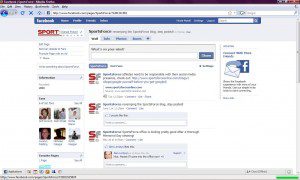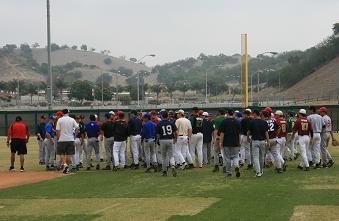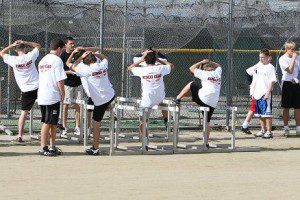Fitness Quest 10: Common Young Athlete Questions and Answers
Posted by SportsForce in High School, Q & A, Training, tags: advice, TrainingCoach Brett Klika is the Director of Athletic Performance at Todd Durkin’s Fitness Quest 10 in San Diego, CA. He specializes in youth fitness and athletic performance, overseeing a staff of 8 strength coaches developing programs for over 300 youth per week, both athletes and non-athletes. In addition to coaching, Brett currently authors for a variety of publications, produces DVD’s on fitness and athletic performance and presents around the world on topics in fitness, wellness, and sports performance. Brett can be reached at brett@fitnessquest10.com .
In my career I have the opportunity to interact with a vast array of parents, coaches, and other fitness professionals eager to improve youngsters’ physical adeptness. I attempt to navigate these professionals through the sea of misinformation and provide time tested, and practical strategies to improve youth fitness and athletic performance. This has turned into hundreds of pages of writing and endless hours of speaking and personal consultation. All of this time and effort has been spent answering a few common questions that I address on a near daily basis while working with youth. Below is a “one stop shop” for some of the most common questions I address, and short, concise answers.
1. Q. How old should my son/daughter be before beginning weight training?
A. Weight training is the introduction of overload to a movement. Overloading a movement with external weight of any kind is only safe and effective when that movement is done biomechanically correct. Furthermore, overload must be introduced in a progressive fashion, always allowing the movement to be executed properly. I recommend that all youth be involved in a movement training program with an experienced professional as young as possible (usually about age 6). The professional my chose to add overload to movement once an array of physical skills and biological capacities have been developed. The question of when to add this overload has more to do with a youngster’s physical fitness and biomechanical abilities than with age. While I am familiar with research on safe weight training with children as young as 6, I recommend consulting with an experienced professional who specializes in youth fitness and athletic development. In my experience unfortunately, I do not recommend the introduction of weight training to youth by parents or athletic coaches.
2. Q. Are supplements safe for kids?
A. The umbrella term “supplements” covers everything from Vitamin C tabs to pro- hormones. Most parents and coaches are asking about creatine, protein-based weight gainers, and NO2 products. In my reading, I have not found definitive research that would suggest that these are dangerous. However, “supplements” are only effective when they “supplement” a perfect diet and training program. I have never met a youth that has both, or either for that matter. The only traditional supplement I recommend for kids is some sort of meal replacement shake that they are willing to drink. These are NOT ideal nutritionally, however, they offer a reasonable nutrition profile and most kids are willing to drink them. Get your kids to eat multiple small meals made up of non-processed food while following a professionally designed training program. The results they will see from this regiment are far superior to any over the counter supplement. As a matter of fact, it is not even comparable.
3. Q. How long will it take for my son/daughter to improve their speed, vertical jump, etc?
A. The factors affecting a youngster’s physical performance are too lengthy to name. There is no piece of technology available that can maximize a youngster’s athletic performance more than a well-designed, longitudinal, progressive, consistent, all encompassing, athletic development program. To permanently improve true game performance and specific physical ability it may take months or years of consistent training. Research has demonstrated that in order to learn a skill, it must be practiced about 10,000 times. Most youngsters see an improvement in general performance merely from improving their physical fitness. This can be accomplished in a relatively short amount of time, usually about 6 weeks of consistent, frequent training. If they were to stop after 6 weeks however, the improvements in physical fitness would diminish, and in turn, their performance improvements. Athletic performance is a longitudinal process in youth that should be viewed as a multi-year commitment.
4. Q. How do I improve my son or daughter’s flexibility?
A. Improving flexibility in pubescent youngsters presents a significant challenge. The bones are growing at an accelerated rate. The places where the muscles originate and attach grow further apart. The muscle responds by contracting slightly to protect itself from the forced elongation. When the muscles are in a near constant state of slight contraction, a significant decrease in mobility (flexibility) is observed. In order to get the muscle to relax, it has to believe that it is not being over-stretched. In order to do this for youngsters, I recommend the following:
- Frequent massage or fascia work. Massage therapy can help break down tight fascia in order to help dampen the contraction. This can also be done using a foam roller or tennis ball.
- Dynamic Mobility Warm-Ups. Youngsters should warm-up with progressive range of motion based exercises. This helps improve the pliability of tissue, allowing for greater range of motion during exercise. For an example of these warm-ups, please see the video below.
- Post work-out static stretching. This is the traditional stretching modality. It is ideal to do this when the muscles are warm and pliable. The helps convince the muscles that the elongation is OK, so they can dampen their contraction.
As I mentioned, these are the most frequently asked questions. If you have a specific question you would like to see addressed, feel free to contact me at brett@fitnessquest10.com This e-mail address is being protected from spam bots, you need JavaScript enabled to view it . Hopefully I am able to navigate you through the sea of misinformation to create youngsters that become happy, healthy, pain-free adults!










